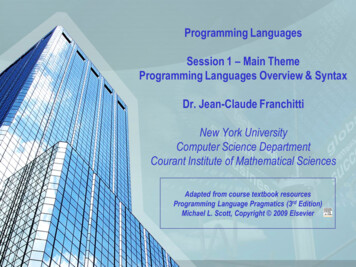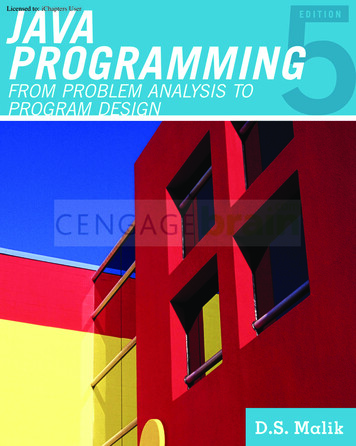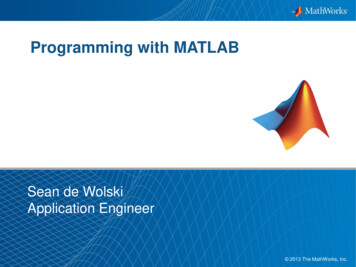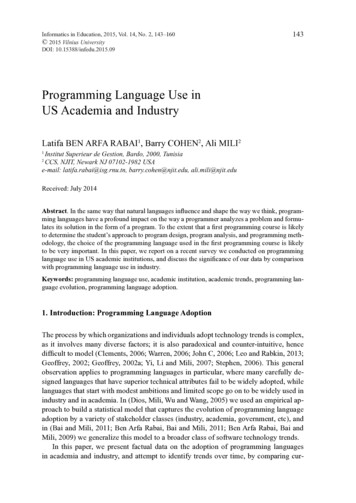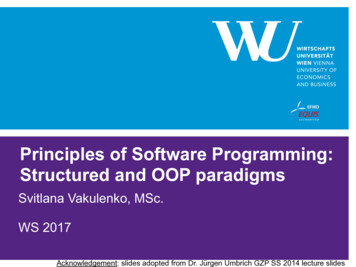
Transcription
The GoProgrammingLanguage
This page intentionally left blank
The GoProgrammingLanguageAlan A. A. DonovanGoogle Inc.Brian W. KernighanPrinceton UniversityNew York Boston Indianapolis San FranciscoToronto Montreal London Munich Paris MadridCapetown Sydney Tokyo Singapore Mexico City
Many of the designations used by manufacturers and sellers to distinguish their products are claimedas trademarks. Where those designations appear in this book, and the publisher was aware of a trademark claim, the designations have been printed with initial capital letters or in all capitals.The authors and publisher have taken care in the preparation of this book, but make no expressedor implied warranty of any kind and assume no responsibility for errors or omissions. No liability isassumed for incidental or consequential damages in connection with or arising out of the use of theinformation or programs contained herein.For information about buying this title in bulk quantities, or for special sales opportunities (whichmay include electronic versions; custom cover designs; and content particular to your business, training goals, marketing focus, or branding interests), please contact our corporate sales department atcorpsales@pearsoned.com or (800) 382-3419.For government sales inquiries, please contact governmentsales@pearsoned.com.For questions about sales outside the United States, please contact international@pearsoned.com.Visit us on the Web: informit.com/awLibrary of Congress Control Number: 2015950709Copyright 2016 Alan A. A. Donovan & Brian W. KernighanAll rights reserved. Printed in the United States of America. This publication is protected by copyright,and permission must be obtained from the publisher prior to any prohibited reproduction, storage in aretrieval system, or transmission in any form or by any means, electronic, mechanical, photocopying,recording, or likewise. To obtain permission to use material from this work, please submit a writtenrequest to Pearson Education, Inc., Permissions Department, 200 Old Tappan Road, Old Tappan, NewJersey 07675, or you may fax your request to (201) 236-3290.Front cover: Millau Viaduct, Tarn valley, southern France. A paragon of simplicity in modern engineering design, the viaduct replaced a convoluted path from capital to coast with a direct route overthe clouds. Jean-Pierre Lescourret/Corbis.Back cover: the original Go gopher. 2009 Renée French. Used under Creative Commons Attributions 3.0 license.Typeset by the authors in Minion Pro, Lato, and Consolas, using Go, groff, ghostscript, and a host ofother open-source Unix tools. Figures were created in Google Drawings.ISBN-13: 978-0-13-419044-0ISBN-10: 0-13-419044-0Text printed in the United States on recycled paper at RR Donnelley in Crawfordsville, Indiana.First printing, October 2015
The Go Programming Language 2016 Alan A. A. Donovan & Brian W. Kernighanrevision 3b600c, date 29 Sep 2015For Leila and Meg
This page intentionally left blank
The Go Programming Language 2016 Alan A. A. Donovan & Brian W. Kernighanrevision 3b600c, date 29 Sep 2015ContentsPrefaceThe Origins of GoThe Go ProjectOrganization of the BookWhere to Find More InformationAcknowledgmentsxixiixiiixvxvixvii1. Tutorial1.1. Hello, World1.2. Command-Line Arguments1.3. Finding Duplicate Lines1.4. Animated GIFs1.5. Fetching a URL1.6. Fetching URLs Concurrently1.7. A Web Server1.8. Loose Ends114813151719232. Program Structure2.1. Names2.2. Declarations2.3. Variables2.4. Assignments2.5. Type Declarations2.6. Packages and Files2.7. Scope2727283036394145vii
The Go Programming Language 2016 Alan A. A. Donovan & Brian W. Kernighanrevision 3b600c, date 29 Sep 2015viii3. Basic Data Types3.1. Integers3.2. Floating-Point Numbers3.3. Complex Numbers3.4. Booleans3.5. Strings3.6. ConstantsCONTENTS515156616364754. Composite Types4.1. Arrays4.2. Slices4.3. Maps4.4. Structs4.5. JSON4.6. Text and HTML Templates81818493991071135. Functions5.1. Function Declarations5.2. Recursion5.3. Multiple Return Values5.4. Errors5.5. Function Values5.6. Anonymous Functions5.7. Variadic Functions5.8. Deferred Function Calls5.9. Panic5.10. Recover1191191211241271321351421431481516. Methods6.1. Method Declarations6.2. Methods with a Pointer Receiver6.3. Composing Types by Struct Embedding6.4. Method Values and Expressions6.5. Example: Bit Vector Type6.6. Encapsulation1551551581611641651687. Interfaces7.1. Interfaces as Contracts7.2. Interface Types7.3. Interface Satisfaction7.4. Parsing Flags with flag.Value7.5. Interface Values171171174175179181
The Go Programming Language 2016 Alan A. A. Donovan & Brian W. Kernighanrevision 3b600c, date 29 Sep 2015CONTENTS7.6. Sorting with sort.Interface7.7. The http.Handler Interface7.8. The error Interface7.9. Example: Expression Evaluator7.10. Type Assertions7.11. Discriminating Errors with Type Assertions7.12. Querying Behaviors with Interface Type Assertions7.13. Type Switches7.14. Example: Token-Based XML Decoding7.15. A Few Words of Adviceix1861911961972052062082102132168. Goroutines and Channels8.1. Goroutines8.2. Example: Concurrent Clock Server8.3. Example: Concurrent Echo Server8.4. Channels8.5. Looping in Parallel8.6. Example: Concurrent Web Crawler8.7. Multiplexing with select8.8. Example: Concurrent Directory Traversal8.9. Cancellation8.10. Example: Chat Server2172172192222252342392442472512539. Concurrency with Shared Variables9.1. Race Conditions9.2. Mutual Exclusion: sync.Mutex9.3. Read/Write Mutexes: sync.RWMutex9.4. Memory Synchronization9.5. Lazy Initialization: sync.Once9.6. The Race Detector9.7. Example: Concurrent Non-Blocking Cache9.8. Goroutines and Threads25725726226626726827127228010. Packages and the Go Tool10.1. Introduction10.2. Import Paths10.3. The Package Declaration10.4. Import Declarations10.5. Blank Imports10.6. Packages and Naming10.7. The Go Tool283283284285285286289290
The Go Programming Language 2016 Alan A. A. Donovan & Brian W. Kernighanrevision 3b600c, date 29 Sep 2015xCONTENTS11. Testing11.1. The go test Tool11.2. Test Functions11.3. Coverage11.4. Benchmark Functions11.5. Profiling11.6. Example Functions30130230231832132332612. Reflection12.1. Why Reflection?12.2. reflect.Type and reflect.Value12.3. Display, a Recursive Value Printer12.4. Example: Encoding S-Expressions12.5. Setting Variables with reflect.Value12.6. Example: Decoding S-Expressions12.7. Accessing Struct Field Tags12.8. Displaying the Methods of a Type12.9. A Word of Caution32932933033333834134434835135213. Low-Level Programming13.1. unsafe.Sizeof, Alignof, and Offsetof13.2. unsafe.Pointer13.3. Example: Deep Equivalence13.4. Calling C Code with cgo13.5. Another Word of Caution353354356358361366Index367
The Go Programming Language 2016 Alan A. A. Donovan & Brian W. Kernighanrevision 3b600c, date 29 Sep 2015Preface‘‘Go is an open source programming language that makes it easy to build simple, reliable,and efficient software.’’ (From the Go web site at golang.org)Go was conceived in September 2007 by Robert Griesemer, Rob Pike, and Ken Thompson, allat Google, and was announced in November 2009. The goals of the language and its accompanying tools were to be expressive, efficient in both compilation and execution, and effectivein writing reliable and robust programs.Go bears a surface similarity to C and, like C, is a tool for professional programmers, achieving maximum effect with minimum means. But it is much more than an updated version ofC. It borrows and adapts good ideas from many other languages, while avoiding features thathave led to complexity and unreliable code. Its facilities for concurrency are new and efficient,and its approach to data abstraction and object-oriented programming is unusually flexible. Ithas automatic memory management or garbage collection.Go is especially well suited for building infrastructure like networked servers, and tools andsystems for programmers, but it is truly a general-purpose language and finds use in domainsas diverse as graphics, mobile applications, and machine learning. It has become popular as areplacement for untyped scripting languages because it balances expressiveness with safety :Go programs typically run faster than programs written in dynamic languages and suffer farfewer crashes due to unexpected type errors.Go is an open-source project, so source code for its compiler, libraries, and tools is freely available to anyone. Contributions to the project come from an active worldwide community. Goruns on Unix-like systems—Linux, FreeBSD, OpenBSD, Mac OS X—and on Plan 9 andMicrosoft Windows. Programs written in one of these environments generally work withoutmodification on the others.xi
The Go Programming Language 2016 Alan A. A. Donovan & Brian W. Kernighanrevision 3b600c, date 29 Sep 2015xiiPREFACEThis book is meant to help you start using Go effectively right away and to use it well, takingfull advantage of Go’s language features and standard libraries to write clear, idiomatic, andefficient programs.The Origins of GoLike biological species, successful languages beget offspring that incorporate the advantages oftheir ancestors; interbreeding sometimes leads to surprising strengths; and, very occasionally,a radical new feature arises without precedent. We can learn a lot about why a language is theway it is and what environment it has been adapted for by looking at these influences.The figure below shows the most important influences of earlier programming languages onthe design of Go.Go is sometimes described as a ‘‘C-like language,’’ or as ‘‘C for the 21st century.’’ From C, Goinherited its expression syntax, control-flow statements, basic data types, call-by-value parameter passing, pointers, and above all, C’s emphasis on programs that compile to efficientmachine code and cooperate naturally with the abstractions of current operating systems.
The Go Programming Language 2016 Alan A. A. Donovan & Brian W. Kernighanrevision 3b600c, date 29 Sep 2015THE ORIGINS OF GOxiiiBut there are other ancestors in Go’s family tree. One major stream of influence comes fromlanguages by Niklaus Wirth, beginning with Pascal. Modula-2 inspired the package concept.Oberon eliminated the distinction between module interface files and module implementationfiles. Oberon-2 influenced the syntax for packages, imports, and declarations, and ObjectOberon provided the syntax for method declarations.Another lineage among Go’s ancestors, and one that makes Go distinctive among recentprogramming languages, is a sequence of little-known research languages developed at BellLabs, all inspired by the concept of communicating sequential processes (CSP) from TonyHoare’s seminal 1978 paper on the foundations of concurrency. In CSP, a program is a parallelcomposition of processes that have no shared state; the processes communicate and synchronize using channels. But Hoare’s CSP was a formal language for describing the fundamentalconcepts of concurrency, not a programming language for writing executable programs.Rob Pike and others began to experiment with CSP implementations as actual languages. Thefirst was called Squeak (‘‘A language for communicating with mice’’), which provided a language for handling mouse and keyboard events, with statically created channels. This wasfollowed by Newsqueak, which offered C-like statement and expression syntax and Pascal-liketype notation. It was a purely functional language with garbage collection, again aimed atmanaging keyboard, mouse, and window events. Channels became first-class values, dynamically created and storable in variables.The Plan 9 operating system carried these ideas forward in a language called Alef. Alef triedto make Newsqueak a viable system programming language, but its omission of garbage collection made concurrency too painful.Other constructions in Go show the influence of non-ancestral genes here and there; forexample iota is loosely from APL, and lexical scope with nested functions is from Scheme(and most languages since). Here too we find novel mutations. Go’s innovative slices providedynamic arrays with efficient random access but also permit sophisticated sharingarrangements reminiscent of linked lists. And the defer statement is new with Go.The Go ProjectAll programming languages reflect the programming philosophy of their creators, which oftenincludes a significant component of reaction to the perceived shortcomings of earlier languages. The Go project was borne of frustration with several software systems at Google thatwere suffering from an explosion of complexity. (This problem is by no means unique toGoogle.)As Rob Pike put it, ‘‘complexity is multiplicative’’: fixing a problem by making one part of thesystem more complex slowly but surely adds complexity to other parts. With constant pressure to add features and options and configurations, and to ship code quickly, it’s easy toneglect simplicity, even though in the long run simplicity is the key to good software.
The Go Programming Language 2016 Alan A. A. Donovan & Brian W. Kernighanrevision 3b600c, date 29 Sep 2015xivPREFACESimplicity requires more work at the beginning of a project to reduce an idea to its essence andmore discipline over the lifetime of a project to distinguish good changes from bad or pernicious ones. With sufficient effort, a good change can be accommodated without compromising what Fred Brooks called the ‘‘conceptual integrity’’ of the design but a bad change cannot,and a pernicious change trades simplicity for its shallow cousin, convenience. Only throughsimplicity of design can a system remain stable, secure, and coherent as it grows.The Go project includes the language itself, its tools and standard libraries, and last but notleast, a cultural agenda of radical simplicity. As a recent high-level language, Go has the benefit of hindsight, and the basics are done well: it has garbage collection, a package system, firstclass functions, lexical scope, a system call interface, and immutable strings in which text isgenerally encoded in UTF-8. But it has comparatively few features and is unlikely to addmore. For instance, it has no implicit numeric conversions, no constructors or destructors, nooperator overloading, no default parameter values, no inheritance, no generics, no exceptions,no macros, no function annotations, and no thread-local storage. The language is mature andstable, and guarantees backwards compatibility: older Go programs can be compiled and runwith newer versions of compilers and standard libraries.Go has enough of a type system to avoid most of the careless mistakes that plague programmers in dynamic languages, but it has a simpler type system than comparable typed languages.This approach can sometimes lead to isolated pockets of ‘‘untyped’’ programming within abroader framework of types, and Go programmers do not go to the lengths that C orHaskell programmers do to express safety properties as type-based proofs. But in practice Gogives programmers much of the safety and run-time performance benefits of a relativelystrong type system without the burden of a complex one.Go encourages an awareness of contemporary computer system design, particularly theimportance of locality. Its built-in data types and most library data structures are crafted towork naturally without explicit initialization or implicit constructors, so relatively few memory allocations and memory writes are hidden in the code. Go’s aggregate types (structs andarrays) hold their elements directly, requiring less storage and fewer allocations and pointerindirections than languages that use indirect fields. And since the modern computer is a parallel machine, Go has concurrency features based on CSP, as mentioned earlier. The variablesize stacks of Go’s lightweight threads or goroutines are initially small enough that creating onegoroutine is cheap and creating a million is practical.Go’s standard library, often described as coming with ‘‘batteries included,’’ provides cleanbuilding blocks and APIs for I/O, text processing, graphics, cryptography, networking, anddistributed applications, with support for many standard file formats and protocols. Thelibraries and tools make extensive use of convention to reduce the need for configuration andexplanation, thus simplifying program logic and making diverse Go programs more similar toeach other and thus easier to learn. Projects built using the go tool use only file and identifiernames and an occasional special comment to determine all the libraries, executables, tests,benchmarks, examples, platform-specific variants, and documentation for a project; the Gosource itself contains the build specification.
The Go Programming Language 2016 Alan A. A. Donovan & Brian W. Kernighanrevision 3b600c, date 29 Sep 2015THE GO PROJECTxvOrganization of the BookWe assume that you have programmed in one or more other languages, whether compiled likeC, C , and Java, or interpreted like Python, Ruby, and JavaScript, so we won’t spell out everything as if for a total beginner. Surface syntax will be familiar, as will variables and constants,expressions, control flow, and functions.Chapter 1 is a tutorial on the basic constructs of Go, introduced through a dozen programs foreveryday tasks like reading and writing files, formatting text, creating images, and communicating with Internet clients and servers.Chapter 2 describes the structural elements of a Go program—declarations, variables, newtypes, packages and files, and scope. Chapter 3 discusses numbers, booleans, strings, and constants, and explains how to process Unicode. Chapter 4 describes composite types, that is,types built up from simpler ones using arrays, maps, structs, and slices, Go’s approach todynamic lists. Chapter 5 covers functions and discusses error handling, panic and recover,and the defer statement.Chapters 1 through 5 are thus the basics, things that are part of any mainstream imperativelanguage. Go’s syntax and style sometimes differ from other languages, but most programmers will pick them up quickly. The remaining chapters focus on topics where Go’s approachis less conventional: methods, interfaces, concurrency, packages, testing, and reflection.Go has an unusual approach to object-oriented programming. There are no class hierarchies,or indeed any classes; complex object behaviors are created from simpler ones by composition,not inheritance. Methods may be associated with any user-defined type, not just structures,and the relationship between concrete types and abstract types (interfaces) is implicit, so aconcrete type may satisfy an interface that the type’s designer was unaware of. Methods arecovered in Chapter 6 and interfaces in Chapter 7.Chapter 8 presents Go’s approach to concurrency, which is based on the idea of communicating sequential processes (CSP), embodied by goroutines and channels. Chapter 9 explains themore traditional aspects of concurrency based on shared variables.Chapter 10 describes packages, the mechanism for organizing libraries. This chapter alsoshows how to make effective use of the go tool, which provides for compilation, testing,benchmarking, program formatting, documentation, and many other tasks, all within a singlecommand.Chapter 11 deals with testing, where Go takes a notably lightweight approach, avoidingabstraction-laden frameworks in favor of simple libraries and tools. The testing librariesprovide a foundation atop which more complex abstractions can be built if necessary.Chapter 12 discusses reflection, the ability of a program to examine its own representationduring execution. Reflection is a powerful tool, though one to be used carefully; this chapterexplains finding the right balance by showing how it is used to implement some important Golibraries. Chapter 13 explains the gory details of low-level programming that uses the unsafepackage to step around Go’s type system, and when that is appropriate.
The Go Programming Language 2016 Alan A. A. Donovan & Brian W. Kernighanrevision 3b600c, date 29 Sep 2015xviPREFACEEach chapter has a number of exercises that you can use to test your understanding of Go, andto explore extensions and alternatives to the examples from the book.All but the most trivial code examples in the book are available for download from the publicGit repository at gopl.io. Each example is identified by its package import path and may beconveniently fetched, built, and installed using the go get command. You’ll need to choose adirectory to be your Go workspace and set the GOPATH environment variable to point to it.The go tool will create the directory if necessary. For example: export GOPATH HOME/gobook go get gopl.io/ch1/helloworld GOPATH/bin/helloworldHello, BF# choose workspace directory# fetch, build, install# runTo run the examples, you will need at least version 1.5 of Go. go versiongo version go1.5 linux/amd64Follow the instructions at https://golang.org/doc/install if the go tool on your computer is older or missing.Where to Find More InformationThe best source for more information about Go is the official web site, https://golang.org,which provides access to the documentation, including the Go Programming Language Specification, standard packages, and the like. There are also tutorials on how to write Go and howto write it well, and a wide variety of online text and video resources that will be valuable complements to this book. The Go Blog at blog.golang.org publishes some of the best writingon Go, with articles on the state of the language, plans for the future, reports on conferences,and in-depth explanations of a wide variety of Go-related topics.One of the most useful aspects of online access to Go (and a regrettable limitation of a paperbook) is the ability to run Go programs from the web pages that describe them. This functionality is provided by the Go Playground at play.golang.org, and may be embeddedwithin other pages, such as the home page at golang.org or the documentation pages servedby the godoc tool.The Playground makes it convenient to perform simple experiments to check one’s understanding of syntax, semantics, or library packages with short programs, and in many waystakes the place of a read-eval-print loop (REPL) in other languages. Its persistent URLs aregreat for sharing snippets of Go code with others, for reporting bugs or making suggestions.Built atop the Playground, the Go Tour at tour.golang.org is a sequence of short interactivelessons on the basic ideas and constructions of Go, an orderly walk through the language.The primary shortcoming of the Playground and the Tour is that they allow only standardlibraries to be imported, and many library features—networking, for example—are restricted
The Go Programming Language 2016 Alan A. A. Donovan & Brian W. Kernighanrevision 3b600c, date 29 Sep 2015WHERE TO FIND MORE INFORMATIONxviifor practical or security reasons. They also require access to the Internet to compile and runeach program. So for more elaborate experiments, you will have to run Go programs on yourown computer. Fortunately the download process is straightforward, so it should not takemore than a few minutes to fetch the Go distribution from golang.org and start writing andrunning Go programs of your own.Since Go is an open-source project, you can read the code for any type or function in the standard library online at https://golang.org/pkg; the same code is part of the downloadeddistribution. Use this to figure out how something works, or to answer questions aboutdetails, or merely to see how experts write really good Go.AcknowledgmentsRob Pike and Russ Cox, core members of the Go team, read the manuscript several times withgreat care; their comments on everything from word choice to overall structure and organization have been invaluable. While preparing the Japanese translation, Yoshiki Shibata went farbeyond the call of duty; his meticulous eye spotted numerous inconsistencies in the Englishtext and errors in the code. We greatly appreciate thorough reviews and critical comments onthe entire manuscript from Brian Goetz, Corey Kosak, Arnold Robbins, Josh Bleecher Snyder,and Peter Weinberger.We are indebted to Sameer Ajmani, Ittai Balaban, David Crawshaw, Billy Donohue, JonathanFeinberg, Andrew Gerrand, Robert Griesemer, John Linderman, Minux Ma, Bryan Mills, BalaNatarajan, Cosmos Nicolaou, Paul Staniforth, Nigel Tao, and Howard Trickey for manyhelpful suggestions. We also thank David Brailsford and Raph Levien for typesetting advice.Our editor Greg Doench at Addison-Wesley got the ball rolling originally and has been continuously helpful ever since. The AW production team—John Fuller, Dayna Isley, Julie Nahil,Chuti Prasertsith, and Barbara Wood—has been outstanding; authors could not hope for better support.Alan Donovan wishes to thank: Sameer Ajmani, Chris Demetriou, Walt Drummond, and ReidTatge at Google for allowing him time to write; Stephen Donovan, for his advice and timelyencouragement; and above all, his wife Leila Kazemi, for her unhesitating enthusiasm andunwavering support for this project, despite the long hours of distraction and absenteeismfrom family life that it entailed.Brian Kernighan is deeply grateful to friends and colleagues for their patience and forbearanceas he moved slowly along the path to understanding, and especially to his wife Meg, who hasbeen unfailingly supportive of book-writing and so much else.New YorkOctober 2015
This page intentionally left blank
The Go Programming Language 2016 Alan A. A. Donovan & Brian W. Kernighanrevision 3b600c, date 29 Sep 20151TutorialThis chapter is a tour of the basic components of Go. We hope to provide enough informationand examples to get you off the ground and doing useful things as quickly as possible. Theexamples here, and indeed in the whole book, are aimed at tasks that you might have to do inthe real world. In this chapter we’ll try to give you a taste of the diversity of programs that onemight write in Go, ranging from simple file processing and a bit of graphics to concurrentInternet clients and servers. We certainly won’t explain everything in the first chapter, butstudying such programs in a new language can be an effective way to get started.When you’re learning a new language, there’s a natural tendency to write code as you wouldhave written it in a language you already know. Be aware of this bias as you learn Go and tryto avoid it. We’ve tried to illustrate and explain how to write good Go, so use the code here asa guide when you’re writing your own.1.1. Hello, WorldWe’ll start with the now-traditional ‘‘hello, world’’ example, which appears at the beginning ofThe C Programming Language, published in 1978. C is one of the most direct influences onGo, and ‘‘hello, world’’ illustrates a number of central ideas.gopl.io/ch1/helloworldpackage mainimport "fmt"func main() {fmt.Println("Hello,}BF")1
The Go Programming Language 2016 Alan A. A. Donovan & Brian W. Kernighanrevision 3b600c, date 29 Sep 20152CHAPTER 1.TUTORIALGo is a compiled language. The Go toolchain converts a source program and the things itdepends on into instructions in the native machine language of a computer. These tools areaccessed through a single command called go that has a number of subcommands. The simplest of these subcommands is run, which compiles the source code from one or more sourcefiles whose names end in .go, links it with libraries, then runs the resulting executable file.(We will use as the command prompt throughout the book.) go run helloworld.goNot surprisingly, this printsHello,BFGo natively handles Unicode, so it can process text in all the world’s languages.If the program is more than a one-shot experiment, it’s likely that you would want to compileit once and save the compiled result for later use. That is done with go build: go build helloworld.goThis creates an executable binary file called helloworld that can be run any time without further processing: ./helloworldHello, BFWe have labeled each significant example as a reminder that you can obtain the code from thebook’s source code repository at gopl.io:gopl.io/ch1/helloworldIf you run go get gopl.io/ch1/helloworld, it will fetch the source code and place it in thecorresponding directory. There’s more about this topic in Section 2.6 and Section 10.7.Let’s now talk about the program itself. Go code is organized into packages, which are similarto libraries or modules in other languages. A package consists of one or more .go source filesin a single directory that define what the package does. Each source file begins with a packagedeclaration, here package main, that states which package the file belongs to, followed by a listof other packages that it imports, and then the declarations of the program that are stored inthat file.The Go standard library has over 100 packages for common tasks like input and output,sorting, and text manipulation. For instance, the fmt package contains functions for printingformatted output and scanning input. Println is one of the basic output functions in fmt; itprints one or more values, separated by spaces, with a newline character at the end so that thevalues appear as a single line of output.Package main is special. It defines a standalone executable program, not a library. Withinpackage main the function main is also special—it’s where execution of the program begins.Whatever main does is what the program does. Of course, main will normally call upon functions in other packages to do much of the work, such as the function fmt.Println.
The Go Programming Language 2016 Alan A. A. Donovan & Brian W. Kernighanrevision 3b600c, date 29 Sep 2015SECTION 1.1. HELLO, WORLD3We must tell the compiler what packages are needed by this source file; that’s the role of theimport declaration that follows the package declaration. Th
5.6. Anony m ou s Fu nc t io ns 135 5.7. Var i adic Functions 142 5.8. Defer r ed FunctionCal l s143 5.9. Panic 148 5.10. Recov e r151 6. Metho ds 155 6.1. Met h od Declarat io ns 155 6.2. Met h od sw it h aPoi nt e rRec ei ve r158 6.3. ComposingTyp es by Str u ct Emb e ddin g161 6.4. Met h od Values andExpressions 164 6.5. Example: Bit Vec t .


